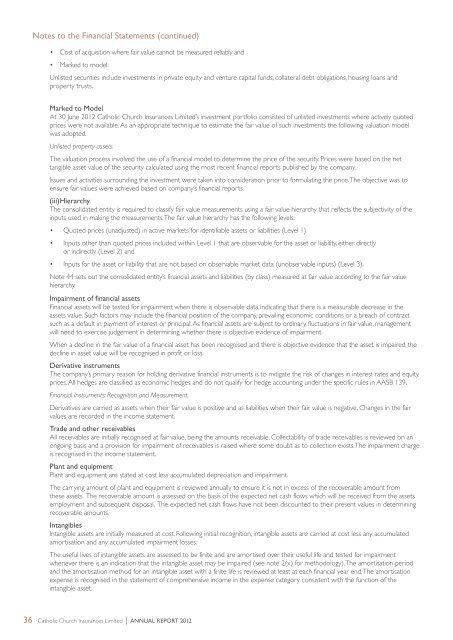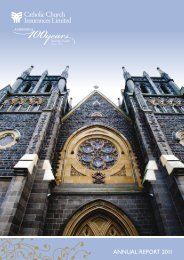CCI Annual Report 2012 - Catholic Church Insurance
CCI Annual Report 2012 - Catholic Church Insurance
CCI Annual Report 2012 - Catholic Church Insurance
Create successful ePaper yourself
Turn your PDF publications into a flip-book with our unique Google optimized e-Paper software.
36<br />
Notes to the Financial Statements (continued)<br />
• Cost of acquisition where fair value cannot be measured reliably and<br />
• Marked to model.<br />
Unlisted securities include investments in private equity and venture capital funds, collateral debt obligations, housing loans and<br />
property trusts.<br />
Marked to Model<br />
At 30 June <strong>2012</strong> <strong>Catholic</strong> <strong>Church</strong> <strong>Insurance</strong>s Limited’s investment portfolio consisted of unlisted investments where actively quoted<br />
prices were not available. As an appropriate technique to estimate the fair value of such investments the following valuation model<br />
was adopted.<br />
Unlisted property assets<br />
The valuation process involved the use of a financial model to determine the price of the security. Prices were based on the net<br />
tangible asset value of the security calculated using the most recent financial reports published by the company.<br />
Issues and activities surrounding the investment were taken into consideration prior to formulating the price. The objective was to<br />
ensure fair values were achieved based on company’s financial reports.<br />
(iii) Hierarchy<br />
The consolidated entity is required to classify fair value measurements using a fair value hierarchy that reflects the subjectivity of the<br />
inputs used in making the measurements. The fair value hierarchy has the following levels:<br />
• Quoted prices (unadjusted) in active markets for identifiable assets or liabilities (Level 1)<br />
• Inputs other than quoted prices included within Level 1 that are observable for the asset or liability, either directly<br />
or indirectly (Level 2) and<br />
• Inputs for the asset or liability that are not based on observable market data (unobservable inputs) (Level 3).<br />
Note 44 sets out the consolidated entity’s financial assets and liabilities (by class) measured at fair value according to the fair value<br />
hierarchy.<br />
Impairment of financial assets<br />
Financial assets will be tested for impairment when there is observable data indicating that there is a measurable decrease in the<br />
assets value. Such factors may include the financial position of the company, prevailing economic conditions or a breach of contract<br />
such as a default in payment of interest or principal. As financial assets are subject to ordinary fluctuations in fair value, management<br />
will need to exercise judgement in determining whether there is objective evidence of impairment.<br />
When a decline in the fair value of a financial asset has been recognised and there is objective evidence that the asset is impaired, the<br />
decline in asset value will be recognised in profit or loss.<br />
Derivative instruments<br />
The company’s primary reason for holding derivative financial instruments is to mitigate the risk of changes in interest rates and equity<br />
prices. All hedges are classified as economic hedges and do not qualify for hedge accounting under the specific rules in AASB 139.<br />
Financial Instruments: Recognition and Measurement.<br />
Derivatives are carried as assets when their fair value is positive and as liabilities when their fair value is negative. Changes in the fair<br />
values are recorded in the income statement.<br />
Trade and other receivables<br />
All receivables are initially recognised at fair value, being the amounts receivable. Collectability of trade receivables is reviewed on an<br />
ongoing basis and a provision for impairment of receivables is raised where some doubt as to collection exists. The impairment charge<br />
is recognised in the income statement.<br />
Plant and equipment<br />
Plant and equipment are stated at cost less accumulated depreciation and impairment.<br />
The carrying amount of plant and equipment is reviewed annually to ensure it is not in excess of the recoverable amount from<br />
these assets. The recoverable amount is assessed on the basis of the expected net cash flows which will be received from the assets<br />
employment and subsequent disposal. The expected net cash flows have not been discounted to their present values in determining<br />
recoverable amounts.<br />
Intangibles<br />
Intangible assets are initially measured at cost. Following initial recognition, intangible assets are carried at cost less any accumulated<br />
amortisation and any accumulated impairment losses.<br />
The useful lives of intangible assets are assessed to be finite and are amortised over their useful life and tested for impairment<br />
whenever there is an indication that the intangible asset may be impaired (see note 2(x) for methodology). The amortisation period<br />
and the amortisation method for an intangible asset with a finite life is reviewed at least at each financial year end. The amortisation<br />
expense is recognised in the statement of comprehensive income in the expense category consistent with the function of the<br />
intangible asset.<br />
<strong>Catholic</strong> <strong>Church</strong> <strong>Insurance</strong>s Limited ANNUAL REPORT <strong>2012</strong>




